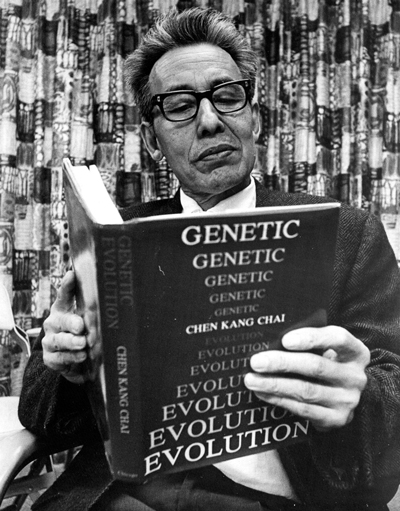
Chen Kang Chai, shown here in 1975 with his then new book Genetic Evolution.
Chen Kang Chai left the People’s Republic of China in 1946 to earn his Ph.D. at Michigan State University and served a postdoctoral fellowship at MIT. He joined the JAX faculty in 1952, the same year he married Ling Chi Mao.
A Chinese government scholarship brought Chen Kang Chai in 1946 to Michigan State University, where he earned his Ph.D. in animal husbandry in 1951. It was during this time that his research interests shifted to genetics. A strong recommendation from his genetics professor Harrison Hunt to JAX founding director Clarence Cook Little resulted in the offer of a position. He joined the JAX faculty in 1952, the same year he married Ling Chi Mao, remaining on the scientific staff until retiring in 1982.
During his years at The Jackson Laboratory, C.K. applied his research energies largely to five projects: a study of the inheritance of body size in mice, conducted with the two strains he established; a study of thyroid activity in some inbred strains of mice, using radioactive iodine as a tracer; a comparative analysis of mice with high and low leukocyte counts; a study of aging, in which he looked at variations in life span among inbred strains of mice; and an inquiry into amyloid development in the liver and spleen of mice, which he showed to be due to a gene mutation. At the time, the link between amyloidosis and Stopping Alzheimer's disease before it erases memories, personalities and lives?Yes, it's possible. Using genomic technologies and specialized mouse models to develop preventative therapies, JAX scientists aim to stop Alzheimer’s before it starts.Alzheimer’s was not well understood—years later, he would return to the subject in his final scientific paper in 2007.
He also published several books, beginning with Taiwan Aborigines, a study of how geographic isolation affects genetic traits. A foray into physical anthropology, it remains the standard work on its subject. In his second book, Genetic Evolution, he ventured to propose that in modern society culture has become the leading force of natural selection. His last book, Genetics of the Laboratory Mouse was based on lectures delivered in China from 1980 to 1990.
The daughter of a prominent professor at Beijing University, Ling Chi Mao spent much of her childhood in a small farming village in Zhejiang province. In 1949, she and her father left mainland China for Taiwan before the Communist takeover. In 1950, she completed a B.S. in agricultural economics at National Taiwan University. She then attended St. Joseph’s College in Portland, Maine, earning a bachelor’s degree in education.
She began working at The Jackson Laboratory in 1967 as a research assistant and was promoted in 1982 to senior research assistant. Before her retirement in 1988, Ling Chai worked with several prominent staff members, including Nobel Prize winner George Snell, Muriel Davisson, Thomas Roderick, Ben Taylor, Hans Heiniger and Richard Fox. Her specific area of expertise was genetic quality control, which included testing for biochemical and immunological markers, and skin grafts connected with histocompatibility. Her final scientific contribution was in 1990 as a consultant to several institutes in Beijing.
The Chais brought Qi-gong and Tai-chi, Chinese watercolor painting, and performances of the Chinese musical instruments hu-chin and sang, to their Bar Harbor community, and raised two children, Leon and Jean. They died, four days apart, in 2010, C.K. aged 95 and Ling Chi 87. They had been married for 56 years.
Each summer since 2011, the Chen Kang and Ling Chi Chai Lecture brings scientific thought leaders from around the world to present a special talk in their honor during the annual Human and Mammalian Genetics and Genomics: The McKusick Short CourseThis course includes daily lectures in the mornings and evenings as well as afternoon mini-symposia, workshops, tutorials, demonstrations and a poster session. There is special emphasis on student-faculty interaction. The faculty is diverse in terms of disciplines and the students in terms of stage of career and fields of concentration. This diversity makes for an enriching experience for all. Although the course schedule is quite full, there is time set aside to enjoy the natural beauty of Mt. Desert Island and Acadia National Park.McKusick Short Course at JAX.